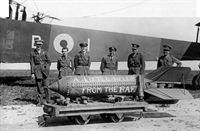Фотографии
-
Following experiences in the Battle of Cambrai in late 1917, in which low-flying aircraft were used extensively for “strafing runs” (leading to a correspondingly high attrition rate), Sopwith developed the sole Camel Trench Fighter (T.F.1), armed with a pair of downward-firing Lewis guns and fitted with armour plating.
Самолёты на фотографии: Sopwith Camel / F.1 - Великобритания - 1916
-
An R.E.8 of No 59 Sqn RFC goes about its work of artillery spotting, reconnaissance and general Army co-operation duties. The unit, formed in August 1916, moved with its R.E.8s to France in February 1917 and began developing invaluable tactical air power methods that would have to be developed all over again in the next war.
Самолёты на фотографии: RAF R.E.8 - Великобритания - 1916
-
Надпись на бомбе - "маленький ад, подарок от RAF" - ранний исторический пример "дарственных" надписей на авиационных средствах поражения. Такие надписи всегда поднимали боевой дух войск.
Members of No 207 Sqn RAF pose beside one of the unit’s Handley Page O/400 bombers, about to be fitted with a gift for the Kaiser, an 1,800lb SN bomb with a personal inscription, at Ligescourt, near Abbeville, in August 1918. Development of a strategic bomber force was to become the central focus of the post-war RAF.Самолёты на фотографии: Handley Page H.P.12 (O/400) - Великобритания - 1917
-
In the summer of 1917 German Gotha bombers made their first forays over England, and the first daylight raid on London by G IVs (a development of the GII seen here) on June 13 resulted in the death of 18 children in a school in Poplar, opening what Air Cdre L.E.O. Charlton later described as “a new epoch in the history of warfare”.
Самолёты на фотографии: Gotha G.II / G.III / G.IV / G.V - Германия - 1916
Статьи
- -
- A.Delalande - Jaguar International in Nigeria
- B.Turpin - 748 into Africa
- E.Martyn - Flying home for the sheep-shearing
- G.Baughen - New model Air Force
- G.Ellis - Snakes in the snow
- J.-C.Carbonel - Narval: The dreaded SNCASO SO.8000
- J.Moralez, V.Militian - Heavy duty: Lebanon's DIY "Hueybombers"
- K.Hayward - A very large & awkward baby
- M.Bearman - Lockheed consternation: Compressibility & the P-38 Lightning
- M.Willis - Trimotors over the Channel
- N.Stroud - Mike Hooks
- P.Davidson - Off the Beaten Track...
- P.Jarrett - Lost & Found
- S.Sumbodo - The Convair 990 and Garuda Indonesian Airways



